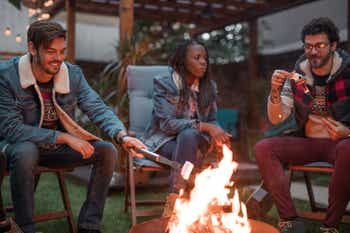As the world starts opening up again, more homeowners are inviting friends and family over for fun outdoor gatherings. If you’re looking for something to spice up your backyard festivities, you can’t go wrong with a fire pit. When the sun sets, nothing is better than roasting marshmallows over an open flame alongside the people you love most.
However, there’s a certain level of precaution you need to take with fire pits. Fire pits that get out of hand can cause wildfires, air pollution, and heat-related injuries. Before buying or building a backyard fire pit, consider our advice and safety tips below so you can enjoy worry-free nights with your favorite people.
Fire Pit Safety
Residential fire pits are legal as long as you follow your county’s laws and regulations. Local authorities put these rules in place to ensure the safety of your home, family, neighbors, and community. If you don’t comply with local fire pit safety rules, you can receive fines and penalties. Additionally, careless handling of your fire pit could result in a devastating wildfire.
Regulations on fire pits can be strict, especially in areas susceptible to wildfires or air pollution. During times of drought or poor air quality, local authorities can issue burn bans to prevent wildfires and air pollution. Also, many areas require a burn permit for any outdoor burning. Be sure to check your county’s fire pit rules online or call your local fire department for information.
Regardless of where you live, you’ll most likely see these common fire pit regulations:
- Avoid placing your fire pit on uneven ground.
- A fire must be attended to and supervised by an adult at all times.
- Don’t light a fire with wind conditions over 15 miles per hour.
- Fires should be no taller and wider than three feet. The higher the fire, the more likely it will spread.
- Keep children and pets at least three feet away from the fire.
How Far Should a Fire Pit Be from Your House?
A safe fire pit distance is another important regulation that most counties implement. Here are some general guidelines your local community might establish:
- Place your fire pit at a safe distance (10-25 feet) from any flammable structures or surfaces. This includes your house, trees, shed, vehicle, neighbors’ property, and wood deck, among other things.
- Keep your fire pit away from overhanging branches. A 21-foot clearance is standard for most municipalities.
- Don’t put your fire pit too close to your property line. The minimum distance between the fire and property line varies from county to county, so be sure to check your local guidelines.
Types of Fire Pits
When it comes to choosing a backyard fire pit, there are a few questions you need to ask yourself. Do you want an in-ground or portable fire pit? Do you want to use wood or gas as your source of fuel? Compare the different types of fire pits available and decide which is best for your home.
In-Ground Fire Pit
If you want your fire pit to be a backyard focal point, a permanent in-ground fire pit is ideal. You can go the DIY route, but if you do, there are important factors to consider:
- First, you need to build a gravel or sand base that’s at least 10 inches deep. This non-combustible base ensures the fire doesn’t make direct contact with the earth.
- The fire pit wall should be 6-12 inches high and made out of non-combustible materials like stone or brick.
- Line your fire pit with heavy-duty metal, so the wall material doesn’t dry out.
Portable Fire Pit
A portable fire pit is a great alternative if you don’t want to commit to a permanent one. There are a lot of different options at your disposal. A fire bowl is a convenient choice available in various materials such as cast iron, copper, and steel. A fire pit table equipped with propane or natural gas offers a stylish look with surface space for food and drinks. You can also get a chimenea — a freestanding fireplace with a vertical smoke vent. Whatever you decide, don’t put your fire pit directly onto the grass. Instead, set it atop a fire-resistant surface like pavers or bricks.
Wood vs. Propane vs. Natural Gas
Wood, propane, and natural gas are the most common fuel sources for fire pits. They each have their pros and cons, so it’s up to you what type of fire pit best suits your backyard.
- Wood — Nothing beats the smoky aroma of a crackling wood-burning fire pit. However, these fire pits are the most regulated, so check your local laws to find out what you can and can’t do.
- Propane — If you value convenience and portability, a propane fire pit makes an excellent choice because you can turn it on with the flick of a switch. They’re also safe fire pits for wood decks since they’re considered appliances instead of fire features. Just make sure to not put combustibles like paper plates or napkins on top of the tabletop surface, especially if there’s no windshield covering the flames.
- Natural Gas — Natural gas fire pits offer the same convenience and safety features as their propane counterparts. Unfortunately, they’re not portable. You need to hook up the fire pit to your home’s gas line via trenching.
Operation Guidelines
You should always be cautious when lighting, maintaining, and extinguishing a fire. Follow these guidelines to ensure you know how to start a fire in a fire pit properly:
- Remove combustible materials such as brush, leaves, and pine needles away from your fire pit area.
- Don’t use gasoline or kerosene to light or relight a fire. These fuels can quickly escalate a fire.
- Avoid wearing synthetic fabrics such as nylon or polyester. These fabrics don’t burn quickly or easily, but they can melt directly into your skin when they do.
- Use water to extinguish the fire. Then, stir and spread the ashes to cool it down. Don’t leave the fire pit until the ashes are cool to the touch.
- Keep a fire extinguisher or bucket of sand nearby in case the fire gets out of control.
What NOT to Burn in a Fire Pit
- Plastic
- Magazines
- Wooden pallets
- Particleboard
- Painted wood
- Cardboard
- Softwood
- Trash, including food and yard waste
Conclusion
Knowing the safety rules and local regulations regarding fire pits can prevent you from receiving fines, polluting the air, and starting a potential wildfire. However, accidents do happen, so make sure you have adequate homeowners insurance to protect you from the unexpected.
Mercury Insurance has you covered. You can file fire-related claims 24 hours a day, seven days a week by calling our claims hotline at (800) 503-3724. Be sure to speak with your Mercury agent to find out if you need additional fire insurance coverage to protect your home in the event of a disaster.


